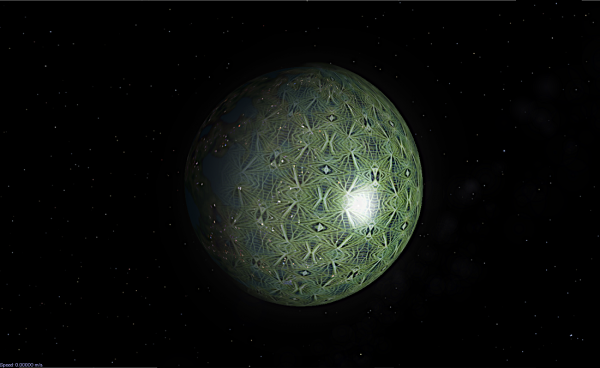BY LETTER
Paraterraforming
Technology > Technology Type or Material > Drytech/Hylotech
Technology > Application > Envirotech
Technology > Technology Levels > High Tech / Hitech
Technology > Application > Infrastructure
Technology > Application > Megascale Engineering
Technology > Application > Envirotech
Technology > Technology Levels > High Tech / Hitech
Technology > Application > Infrastructure
Technology > Application > Megascale Engineering
 Image from Steve Bowers | |
| A small, airless world covered with two separate worldhouse roofs, with a narrow strip between at the equator which allows interplanetary spacecraft access to the original rocky surface | |
Paraterraforming involves the construction of large pressurised habitats which contain a breathable atmosphere at a maintained temperature, on a barren and often airless planet. The first steps towards paraterraformation of a world involve the construction of individual domed habitats, but as the population of the world increases these domes become larger and more numerous until they join together into contiguous structures.
Eventually the domes may be replaced by a worldhouse roof, a tough membrane which is largely supported by air pressure but may have any number of supporting pillars where necessary. The membrane can consist of several layers of decreasing pressure to decrease the pressure differential. Most modern forms of worldhouse roof are self-repairing and can cope with small-to-moderate meteor impacts.
Paraterraforming has several advantages over full-scale terraforming. For example the worldhouse starts out as a series of small domed habitats which can be extended gradually when resources are available. The number of size of the habitats can be quite easily tailored to match demand.
In addition, paraterraforming reduces the requirement for atmospheric gases and other volatiles that are needed to create a habitable environment. Using space envelopes of various kinds even asteroids can be given a habitable environment. The environment under an artificial worldhouse roof can also be altered more readily to reflect changing environmental needs or tastes.
Several forms of paraterraforming technology are grown organically using tailored biotech; examples include canopy plants and greenbubbles, and the Yggdrasil bush. Many Dyson tree (Orwood) variants incorporate habitable compartments within their structure.
 Image from Steve Bowers | |
| Piav, a small world which is completely covered in an organic worldroof known as a Canopy Plant | |
Related Articles
- Adaptationism - Text by Anders Sandberg
The view that people should not adopt planets to suit themselves, but instead adapt to the planet. Adaptationists generally have a distaste for terraforming projects, or opt for only minimal terraforming, but instead prefer to use pantropy. - Bluesky Worldhouses
- Canopy Plant
- Greenbubbles (Space Canopies)
- Low World Houses
- Terraformer Swarms
- Terraforming
- Terraforming Remnants - Text by Anders Sandberg
Natural and artificial ecospheres left by any of several long-vanished terraformer species known only for the biospheres they left behind long ago. Currently terragenkind is busy terraforming suitable planets in the galaxy, and even if they disappear there are going to be lots of human- and ai- derived biospheres left behind. In a few hundreds of millions of years intelligent life might evolve independently there. This life would find a few other habitable worlds with suspiciously similar biochemistries. - Worldhouses
- Yggdrasil Bush, Yggy
Appears in Topics
Development Notes
Text by M. Alan Kazlev and Steve Bowers
Original concept by Richard Taylor, Journal of the British Interplanetary Society, Vol. 45, August 1992, pp. 341-352
Initially published on 19 December 2001.
Original concept by Richard Taylor, Journal of the British Interplanetary Society, Vol. 45, August 1992, pp. 341-352
Initially published on 19 December 2001.






